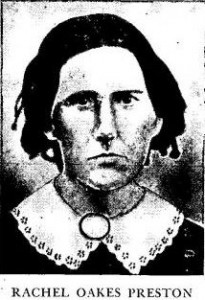 The Civil War era is marked by a number of religious subplots that involve Baptists. One such narrative is the birth and early years of the Seventh-Day Adventist Church.
The Civil War era is marked by a number of religious subplots that involve Baptists. One such narrative is the birth and early years of the Seventh-Day Adventist Church.
In the early 1820s, a Vermont Baptist minister, William Miller, became convinced that Postmillennialism (the prevailing Christian view, in the Western world, of the second coming of Christ, Postmillennialism viewed modern progress as an unfolding golden age after which Christ would return to earth) was incorrect, and that Christ would return to earth on or before 1844. In the early 1830s, Miller began promoting his views through public lectures and in the Vermont Telegraph, a Baptist newspaper. His views attracted a growing following, eventually resulting in the establishment of what became known as the Millerite movement in the early 1840s. The date of October 22, 1844 was eventually established as the expected return of Christ, with up to 100,000 believers eagerly awaiting the fulfillment of biblical prophecy on that day.
Although the Second Coming of Christ did not happen as Miller and his followers anticipated, the movement persevered, arguing that Christ had returned “spiritually” (instead of physically). Becoming known as Adventists, the movement splintered into several different factions. One such splinter group became known as Seventh-Day Adventists. Once again, a Vermont-born Baptist played a leading role, this time in the town of Washington, New Hampshire.
In April, 1842, a group of citizens whose farms stretched over these hillsides banded together to form “The First Christian Society in Washington, New Hampshire.” Because the places where they worshiped were, as they expressed it, too “straight for them” they decided to “erect a small, neat and commodious house” to be “dedicated to the worship of God.” Plans called for a building “30 by 40 feet, one story high, the posts about 15 feet.”
In the Adventist movement of 1842 and 1843 the members of this “Christian Society” espoused the Advent hope. Shortly thereafter, Rachel Oakes, a Seventh-day Baptist, moved to the community, worshiped with the Adventists, and distributed tracts on the importance of keeping the seventh day as the Sabbath. The result was that on a Sunday morning in the autumn of 1844 William Farnsworth arose in the congregation and stated that he intended to observe the seventh day Sabbath. His wife, his brother Cyrus, and about a dozen others joined him. All were disfellowshiped for their stand.
There the narrative remains until this month, when:
… the Sabbathkeepers here in Washington, after meeting for years as a loosely knit company, organized into a Seventh-day Adventist Church, with William and Cyrus Farnsworth as charter members. In the decade that followed, the majority of the Christian Society Group accepted the seventh day Sabbath, and as a consequence the church property passed to Seventh-day Adventist control.
Thus the story of Rachel Oakes Preston, Seventh Day Baptist, reaches an improbable point in the formal organization of the Seventh-Day Adventist Church. Both Miller and Oakes, in the larger historical context, helped foster millennial expectations that contributed to the religious fervor in America leading up to the Civil War.
Oakes, following a move back to Vermont, dies in her home state in 1868.
Sources: Commemorative plaque on the grounds of the Seventh-Day Adventist Church of Washington, New Hampshire (link); brief history of the Seventh-Day Adventist Church (link); image of Rachel Oakes Preston (link)


